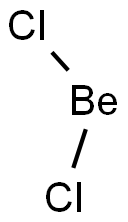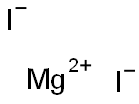beryllium dibromide
- CAS NO.:7787-46-4
- Empirical Formula: BeBr2
- Molecular Weight: 168.820182
- EINECS: 2321159
- SAFETY DATA SHEET (SDS)
- Update Date: 2024-12-18 14:08:52

What is beryllium dibromide?
Chemical properties
orthorhombic; very hygroscopic; -80 mesh, 99% purity; enthalpy of fusion 9.80 kJ/mol; made by reaction of Be and Br2 at 500°C–700°C [KIR78] [CER91] [MER06] [CRC10]
The Uses of beryllium dibromide
Beryllium fluoride is used in biochemistry, particularly protein crystallography, since it binds in some of the same ways as phosphate does in human tissues. ADP and beryllium fluoride together tend to bind to ATP sites and inhibit protein action, making
Preparation
Beryllium bromide has the formula BeBr2. It is very
hygroscopic and is soluble in water. It has the molecular
weight of 168.821 g/mol. The structure has not been
documented. Beryllium bromide can be prepared by
reacting Be metal with elemental bromine at temperatures
of 500°C–700°C:
Be+Br2→BeBr2
Beryllium bromide is also formed when beryllium
oxide with HBr in aqueous solution or hydrogen
bromide in the gas phase:
BeO+2HBr→BeBr2+H2O
This bromide compound was first prepared by Wohler
(1828) by the action of bromine vapor on the metal
and also upon a mixture of carbon and beryllium oxide.Berthemot (1831) obtained it in solution by dissolving
the oxide in hydrobromic acid. Humpridge (1883) also
prepared it by acting on a mixture of the oxide and
carbon with dry bromine.
The anhydrous bromide is always obtained by sublimation
as colorless white crystals.
Properties of beryllium dibromide
| Melting point: | 506-509°; also reported as 488° |
| Boiling point: | bp 520° |
| Density | 3.465 |
| solubility | very soluble in H2O; soluble in ethanol, pyr |
| form | orthorhombic crystals |
| color | orthorhombic crystals, crystalline; hygroscopic |
| Water Solubility | very soluble H2O [MER06] |
| EPA Substance Registry System | Beryllium bromide (BeBr2) (7787-46-4) |
Safety information for beryllium dibromide
Computed Descriptors for beryllium dibromide
New Products
Tert-butyl bis(2-chloroethyl)carbamate (S)-3-Aminobutanenitrile hydrochloride N-Boc-D-alaninol N-BOC-D/L-ALANINOL N-octanoyl benzotriazole 4-Hydrazinobenzoic acid 3,4-Dibenzyloxybenzaldehyde 3-Nitrobenzaldehyde 1,1’-CARBONYLDIIMIDAZOLE R-2-BENZYLOXY PROPIONIC ACID 1,1’-CARBONYLDI (1,2-4 TRIAZOLE) 4-HYDROXY BENZYL ALCOHOL 3-NITRO-2-METHYL ANILINE (2-Hydroxyphenyl)acetonitrile 5-BROMO-2CYANO PYRIDINE 5,6-Dimethoxyindanone 5-broMo-2-chloro-N-cyclopentylpyriMidin-4-aMine 2-(Cyanocyclohexyl)acetic acid 4-methoxy-3,5-dinitropyridine 2-aminopropyl benzoate hydrochloride 1-(4-(aminomethyl)benzyl)urea hydrochloride tert-butyl 4- (ureidomethyl)benzylcarbamate diethyl 2-(2-((tertbutoxycarbonyl)amino) ethyl)malonate Ethyl-2-chloro((4-methoxyphenyl)hydrazono)acetateRelated products of tetrahydrofuran








You may like
-
 873-83-6 6-Aminouracil (or) 4-Amino-2,6- dihydroxypyrimidine, (or) 6-Amino2,4-pyrimidinediol 99%View Details
873-83-6 6-Aminouracil (or) 4-Amino-2,6- dihydroxypyrimidine, (or) 6-Amino2,4-pyrimidinediol 99%View Details
873-83-6 -
 55441-95-7 99%View Details
55441-95-7 99%View Details
55441-95-7 -
 N-Vinylformamide 99%View Details
N-Vinylformamide 99%View Details
13162-05-5 -
 Chloro Uracil 1820-81-1 99%View Details
Chloro Uracil 1820-81-1 99%View Details
1820-81-1 -
 207557-35-5 99%View Details
207557-35-5 99%View Details
207557-35-5 -
 2-ethyl-6-methyl-3-hydroxypyridine succinate 99%View Details
2-ethyl-6-methyl-3-hydroxypyridine succinate 99%View Details
127464-43-1 -
 2-ETHYLPYRIDINE 100-71-0 99%View Details
2-ETHYLPYRIDINE 100-71-0 99%View Details
100-71-0 -
 181228-33-1 (S)-Methyl 3-amino-2-((tert-butoxycarbonyl)amino)propanote Hydrochloride (DAP-OMe. HCl) 99%View Details
181228-33-1 (S)-Methyl 3-amino-2-((tert-butoxycarbonyl)amino)propanote Hydrochloride (DAP-OMe. HCl) 99%View Details
181228-33-1